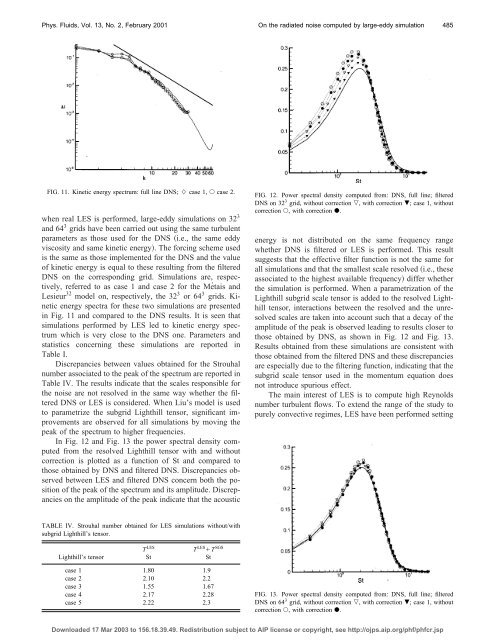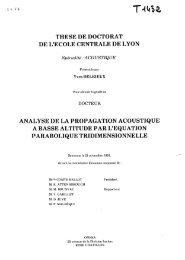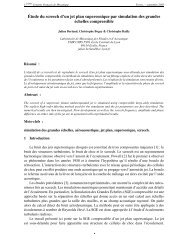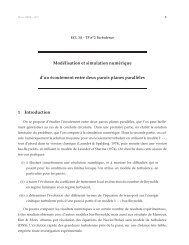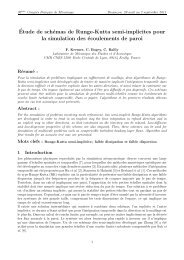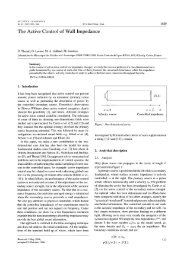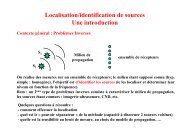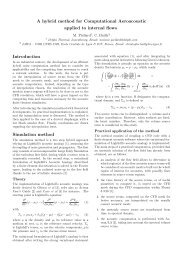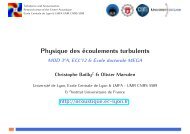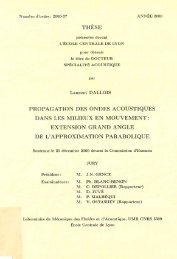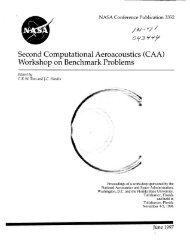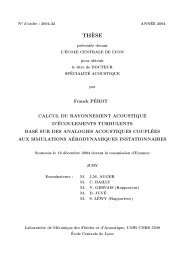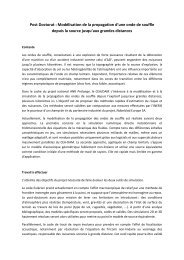On the radiated noise computed by large-eddy simulation
On the radiated noise computed by large-eddy simulation
On the radiated noise computed by large-eddy simulation
Create successful ePaper yourself
Turn your PDF publications into a flip-book with our unique Google optimized e-Paper software.
Phys. Fluids, Vol. 13, No. 2, February 2001 <strong>On</strong> <strong>the</strong> <strong>radiated</strong> <strong>noise</strong> <strong>computed</strong> <strong>by</strong> <strong>large</strong>-<strong>eddy</strong> <strong>simulation</strong><br />
FIG. 11. Kinetic energy spectrum: full line DNS; case 1, case 2.<br />
when real LES is performed, <strong>large</strong>-<strong>eddy</strong> <strong>simulation</strong>s on 32 3<br />
and 64 3 grids have been carried out using <strong>the</strong> same turbulent<br />
parameters as those used for <strong>the</strong> DNS i.e., <strong>the</strong> same <strong>eddy</strong><br />
viscosity and same kinetic energy. The forcing scheme used<br />
is <strong>the</strong> same as those implemented for <strong>the</strong> DNS and <strong>the</strong> value<br />
of kinetic energy is equal to <strong>the</strong>se resulting from <strong>the</strong> filtered<br />
DNS on <strong>the</strong> corresponding grid. Simulations are, respectively,<br />
referred to as case 1 and case 2 for <strong>the</strong> Métais and<br />
Lesieur 32 model on, respectively, <strong>the</strong> 32 3 or 64 3 grids. Kinetic<br />
energy spectra for <strong>the</strong>se two <strong>simulation</strong>s are presented<br />
in Fig. 11 and compared to <strong>the</strong> DNS results. It is seen that<br />
<strong>simulation</strong>s performed <strong>by</strong> LES led to kinetic energy spectrum<br />
which is very close to <strong>the</strong> DNS one. Parameters and<br />
statistics concerning <strong>the</strong>se <strong>simulation</strong>s are reported in<br />
Table I.<br />
Discrepancies between values obtained for <strong>the</strong> Strouhal<br />
number associated to <strong>the</strong> peak of <strong>the</strong> spectrum are reported in<br />
Table IV. The results indicate that <strong>the</strong> scales responsible for<br />
<strong>the</strong> <strong>noise</strong> are not resolved in <strong>the</strong> same way whe<strong>the</strong>r <strong>the</strong> filtered<br />
DNS or LES is considered. When Liu’s model is used<br />
to parametrize <strong>the</strong> subgrid Lighthill tensor, significant improvements<br />
are observed for all <strong>simulation</strong>s <strong>by</strong> moving <strong>the</strong><br />
peak of <strong>the</strong> spectrum to higher frequencies.<br />
In Fig. 12 and Fig. 13 <strong>the</strong> power spectral density <strong>computed</strong><br />
from <strong>the</strong> resolved Lighthill tensor with and without<br />
correction is plotted as a function of St and compared to<br />
those obtained <strong>by</strong> DNS and filtered DNS. Discrepancies observed<br />
between LES and filtered DNS concern both <strong>the</strong> position<br />
of <strong>the</strong> peak of <strong>the</strong> spectrum and its amplitude. Discrepancies<br />
on <strong>the</strong> amplitude of <strong>the</strong> peak indicate that <strong>the</strong> acoustic<br />
TABLE IV. Strouhal number obtained for LES <strong>simulation</strong>s without/with<br />
subgrid Lighthill’s tensor.<br />
Lighthill’s tensor<br />
T LES<br />
St<br />
T LES T SGS<br />
St<br />
case 1 1.80 1.9<br />
case 2 2.10 2.2<br />
case 3 1.55 1.67<br />
case 4 2.17 2.28<br />
case 5 2.22 2.3<br />
485<br />
FIG. 12. Power spectral density <strong>computed</strong> from: DNS, full line; filtered<br />
DNS on 32 3 grid, without correction , with correction ; case 1, without<br />
correction , with correction .<br />
energy is not distributed on <strong>the</strong> same frequency range<br />
whe<strong>the</strong>r DNS is filtered or LES is performed. This result<br />
suggests that <strong>the</strong> effective filter function is not <strong>the</strong> same for<br />
all <strong>simulation</strong>s and that <strong>the</strong> smallest scale resolved i.e., <strong>the</strong>se<br />
associated to <strong>the</strong> highest available frequency differ whe<strong>the</strong>r<br />
<strong>the</strong> <strong>simulation</strong> is performed. When a parametrization of <strong>the</strong><br />
Lighthill subgrid scale tensor is added to <strong>the</strong> resolved Lighthill<br />
tensor, interactions between <strong>the</strong> resolved and <strong>the</strong> unresolved<br />
scales are taken into account such that a decay of <strong>the</strong><br />
amplitude of <strong>the</strong> peak is observed leading to results closer to<br />
those obtained <strong>by</strong> DNS, as shown in Fig. 12 and Fig. 13.<br />
Results obtained from <strong>the</strong>se <strong>simulation</strong>s are consistent with<br />
those obtained from <strong>the</strong> filtered DNS and <strong>the</strong>se discrepancies<br />
are especially due to <strong>the</strong> filtering function, indicating that <strong>the</strong><br />
subgrid scale tensor used in <strong>the</strong> momentum equation does<br />
not introduce spurious effect.<br />
The main interest of LES is to compute high Reynolds<br />
number turbulent flows. To extend <strong>the</strong> range of <strong>the</strong> study to<br />
purely convective regimes, LES have been performed setting<br />
FIG. 13. Power spectral density <strong>computed</strong> from: DNS, full line; filtered<br />
DNS on 64 3 grid, without correction , with correction ; case 1, without<br />
correction , with correction .<br />
Downloaded 17 Mar 2003 to 156.18.39.49. Redistribution subject to AIP license or copyright, see http://ojps.aip.org/phf/phfcr.jsp


